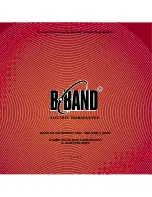
FT-2000
Operating Manual
Vertex Standard Co., Ltd.
92
of 50 standard CTCSS tones are provided (see the CTCSS Tone Chart).
5. Press the [AM/FM] Mode button to select the desired repeater shift direction. The
selections are:
“S” “+” “–“ “S”
where “S” represents “Simplex” operation (not used on a repeater).
6. Press and hold in the [AM/FM] button for two seconds to exit from the repeater
setup mode.
7. Close the microphone’s PTT switch (or press the [MOX] button) to begin
transmission. You will observe that the frequency has shifted to correspond to the
programming you set up in the previous steps. Speak into the microphone in a
normal voice level, and release the PTT switch or [MOX] button to return to the
receive mode.
Advice:
The conventional repeater shift used on 29 MHz is 100 kHz, while on the 50 MHz band
the shift may vary between 500 kHz and 1.7 MHz (or more). To program the proper
repeater shift, use Menu items “073 F3E 28 RPT” (28 MHz) and “074 F3E 50 RPT” (50
MHz), as appropriate.
You may also use “Tone Squelch” whereby your receiver will be kept silent until an
incoming signal bearing a matching CTCSS tone is receiver. Your receiver’s squelch
will then open in response to the reception of the required tone.
1. Rotate the Main tuning Dial to the output frequency (downlink) from the repeater.
2. Press and hold in the [AM/FM] button for two seconds to engage the CTCSS mode.
3. Rotate the Main Tuning Dial to choose “ts”. The available choices are
“OFF” “tn” “ts” “OFF.”
4. Rotate the [SUB VFO-B] knob to select the desired CTCSS Tone to be used. A total
of 50 standard CTCSS tones are provided (see the CTCSS Tone Chart).
5. Press and hold in the [AM/FM] button for two seconds. On the display, just below
the “1 Hz” frequency digit, a small “d” will indicate that the Tone Decoder is
engaged.
Memory Operation
Convenient Memory functions
The FT-2000 contains ninety-nine regular memories, labeled “01” through “99,” nine
special programmed limit memory pairs, labeled “P-1L/1U” through “P-9L/9U,” and















































